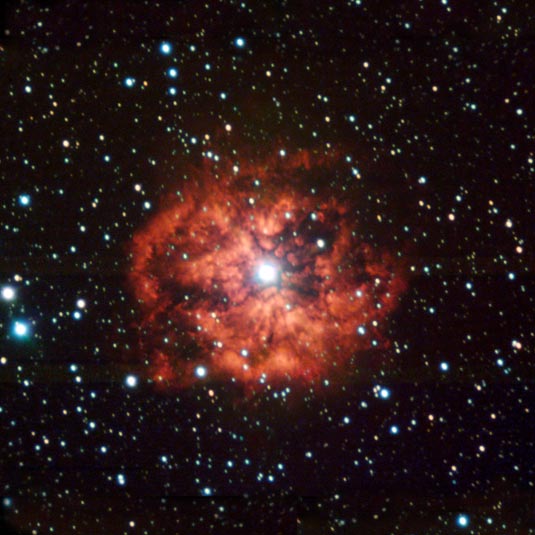
Description: Wolf-Rayet star
Position: RA: 19h 11m 30.92s Dec: 16° 51' 37.95"
Constellation: Sagitta
Distance: 10,000 light years
Field of view: 3.29 x 2.81 arcminutes
Orientation: North is 0.2° left of vertical
Image Credit: ESO
Release Date: December 3, 2009
1998 Image: N9838
ABOUT THIS IMAGE:
M1-67 is the youngest wind-nebula around a Wolf-Rayet star, called WR124, in our Galaxy. These Wolf-Rayet stars start their lives with dozens of times the mass of our Sun, but loose most of it through a powerful wind, which is ultimately responsible for the formation of the nebula.
Ten years ago, Hubble Space Telescope observations revealed a wealth of small knots and substructures inside the nebula. The same team, led by Cédric Foellmi (ESO), has now used ESO's Very Large Telescope (VLT) to watch how these structures have evolved and what they can teach us about stellar winds, their chemistry, and how they mix with the surrounding interstellar medium, before the star will eventually blow everything away in a fiery supernova explosion.
The image is based on FORS1 data obtained by the Paranal Science team with the VLT through 2 wide (B and V) and 3 narrow-band filters.
From Wikipedia:
WR 124 is a Wolf-Rayet star in the constellation of Sagitta. It has an estimated mass of 20 solar masses. In the past, the star could have been much larger, but it has blown away a large portion of its mass through the intense stellar winds of the Wolf-Rayet phase. With an estimated surface temperature of 50 000 K (50 000 °C / 90 000 °F), WR 124 is one of the hottest Wolf-Rayet stars known. WR 124 is surrounded by an intensely hot nebula which began forming about 10000 years ago from the star's extreme stellar wind.
The
Nebula (called M1-67) is expanding at a rate of over 150'000KpH, and is
currently 2.98 light years across, not large enough to have come into
contact with the interstellar medium. M1-67 has little internal structure,
though large clumps of material have been detected, some of which have
30 times the mass of earth and stretch out up to 150 billion km (90 billion
miles). If placed in our solar system, one of these clumps would span
the distance from the sun to Saturn. WR 124 can be seen as a glowing body
in the center of a gigantic fireball.